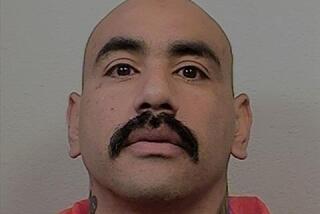Slow-Motion Mass Murder
Rony Brock was readying himself to fight in Afghanistan when he died on the streets of Los Angeles. Suspected gang members killed the 19-year-old Marine last month on the doorstep of his mother’s Boyle Heights home.
Soledad Brock heard it all through her bedroom window. Hears it still, every night as she tries to sleep, and first thing every morning. The question asked by gang members itching for trouble: “Where are you from?” And her son’s answer, the one that is supposed to buy safe passage for those not in a gang: “Nowhere.” Then crack-crack-crack-crack-crack-crack!
For a decade or so it looked as if Los Angeles’ gang problem was abating. Now the opposite may be true. And now seems a good time for the city to finally stand up to the street gangs that terrorize communities, to tell them that their slow-motion mass murder must end.
Homicide sends more Californians between the ages of 15 and 19 to the morgue than even car accidents, the No. 1 killer nationwide. In almost 60% of Los Angeles’ slayings last year the shooter or the victim or both belonged to a gang. California has more gangs than any other state. And Los Angeles has more gangs than any other city.
The Police Department puts the number of gangs here at 407 and the number of gang members at 55,760. Driving this city’s streets and shopping in its markets are members of profit-oriented Salvadoran gangs and hate-driven skinhead gangs. Subsets of Crips and Bloods fill Los Angeles’ classrooms and idle in its parks. This is a city of Mexican American gangs whose roots go back four generations and Vietnamese gangs that flowered when the “boat people” began arriving after Saigon’s fall.
Don’t think the phenomenon is new. Two hundred years ago Irish, Italian, Jewish and German gangs formed in the young nation’s rapidly shifting ethnic slums to pick pockets, run rum and knife each other over crumbs from the Industrial Revolution. What changed in the last 30 years, besides racial and ethnic makeup, were scope and scale. Gangs are no longer limited to large cities. And, armed with Glocks and shotguns, they are far more deadly.
From 1993 to 1999, California’s homicide rate dropped to 30-year lows, a trend seen nationwide. Since 2000, the number of homicides has begun to creep back up. They are still far below the peak--except for gang- related shootings. In 1993, law enforcement linked gang members to 346 of 1,077 homicides in Los Angeles. That’s 32%, a proportion that held fairly steady over the next six years. In 2000 and again in 2001, however, gangsters had a hand in almost 60% of the city’s homicides. The 2001 total, 587, was about half what it had been in 1993. The number of gang- related deaths--346--was exactly the same.
Two years do not a pattern make, but 2002 is well on its way to making it three. The body count in the LAPD’s Hollenbeck Division, which patrols Boyle Heights, stands at 17 already--not counting anyone gunned down last night.
As of March 9, the toll was 109 citywide, compared with 89 at this time last year and 70 the year before that. Last week alone killers claimed 13 people in 11 unrelated shootings--four in drive-bys, one by a rival gang, another caught in the cross-fire of a chase. One gunman asked “Where you from?” then killed a father in front of his son.
Add to these numbers the wounded (at least six, one critically), the families left bereft, neighborhoods terrorized, emergency room resources strained and back come memories of the fear that swept Los Angeles in the late 1980s, climaxing in the 1992 riots, an explosion of violence rooted in many of the same social and economic conditions that fuel gangs.
Could it get that bad again? Consider the slowed economy. Consider the estimated 127,000 inmates who will walk out the doors of California prisons this year. Consider the massing swarm of Californians in the crime-prone adolescent years--3.9 million today, nearly 5 million by 2008.
Now consider whether this might not be a good time to get serious about street gangs, to stand up to the young bullies who prey on their innocent peers, to help steer those peers away from a life that all too often follows this path: jail, prison, hospital, coroner’s van.
This nation has had 200 years of gang violence--time enough, one would think, to figure out ways to eliminate this domestic terrorist threat. Throughout this 10th-anniversary year of the riots we will discuss what works, here and elsewhere, to quell gang violence--and what fails. We’ll explore communities struggling to become neighborhoods again, rather than war zones.
Rony Brock lived--and died--in the sort of neighborhood that’s all too typical in this town of backyard putting greens and hillside infinity pools: Hieroglyphics spray-painted on buildings that good people wear themselves out maintaining. Mothers afraid to make eye contact with the tattooed young men in the dilapidated house next door. Children who can tell from the timbre of the crack-crack-crack whether a shooter fired .22- or .38-caliber rounds.
At his funeral, with its flag-draped coffin and honor guard, the friends and neighbors who packed the church and spilled outside asked over and over, “Why Rony? Why him?” He played football and basketball, earned money doing chores after school, made friends everywhere. His mother had always encouraged him to make something of himself. After graduating from Roosevelt High in May, he enlisted in the Marines. He wanted, he said, to buy his mom a nice house in a safe neighborhood.
Why aren’t all this city’s neighborhood’s safe?
More to Read
Sign up for Essential California
The most important California stories and recommendations in your inbox every morning.
You may occasionally receive promotional content from the Los Angeles Times.










